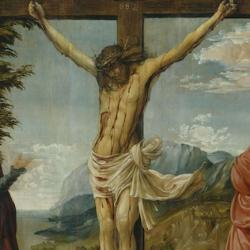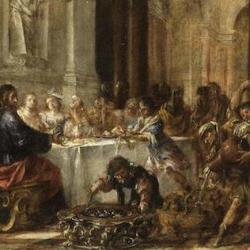Since the Son is incarnate, argues Aaron Riches in his Ecce Homo, “we must speak of unum esse simpliciter,” yet Constantinople II determined that the Son is persona composita. Thus, in the words of Aquinas, “there is another being of this suppositum . . . insofar as it became a man in time.” Riches glosses this with: “In this regard, we speak of Christ’s secundarium esse, which is not the esse principale of his suppositum, but is rather the mode according to which the divine Son truly receives his human being from someone concrete: the Theotokos” (224).
Thus, the divine Son “truly receives his particular human nature ex Maria,” and “allows his human particularity to be constituted in the specificity of her flesh, by her humanity, by her concrete genealogy and by the history of her people.” The son is “irreducibly both ex Patre and ex Maria,” not that he “possesses an individuated mode of being discrete from his divine individuality . . . [but] that the particularity of Jesus human nature is concretely inherited in a way that it cannot be understood solely in reference to his eternal filiation” (224).
Riches is closing the gap between Scotus and Thomas, arguing that the Thomist notion of a secundarium esse “implies a doctrine of haecceity,” though “not as a formal ontological constituent of haec natura.” Thomas’s notion of secondary being instead places the constitution of the Son’s human nature “within the finite field of contingent relationality in which it is incarnated.” This field of relationality is possible because of the “fluid exchange” between Jesus and Mary, an exchange that, Riches argues, is “re-incarnated in every mystical encounter with Christ” because that mystical encounter can take place only “within concrete history as an unrepeatable event of the recognition of a genuine ‘other,’ a historical figure with a genealogy who cannot be reduced to an abstraction” (225).
An encounter with Christ in His particularity is thus necessarily an encounter also with Mary, since the human particularity of Jesus comes from her: “The particularity of the human Jesus cannot be thought of or accounted for outside the Jesus-Mary relation because the esse personale of the divine Son is human only to the extent that he receives himself ex Maria” (225).
This supports Ratzinger’s claim: “The appearance of a truly Marian awareness serves as the touchstone indicating whether or not the christological substance is fully present. Nestorianism involves the fabrication of a Christology from which the nativity and the Mother are removed, a Christology without mariological consequences. Precisely this operation, which surgically removes God so far from man that nativity and maternity—all of corporeality—remain in a different sphere, indicated unambiguously to the Christian consciousness that the discussion no longer concerned Incarnation . . . that the center of Christ’s mystery was endangered, if not already destroyed. Thus in Mariology Christology was defended. Far from belittling Christology, it signifies the comprehensive triumph of a confession of faith in Christ which has achieved authenticity” (quoted 225-6).
Following Louis Chardon, Riches emphasizes the uniqueness of Mary’s relation to Jesus, her “double relation” to God, as both creature and Theotokos. The fact that she “encompassses God in her womb” makes her the “prototype of adoptive filiation” and “the first an exemplary member of his mystical body and therefore the personal representative of mystical union” (228). And more than prototype: “in her mode of being the first and perfect receptacle of the divine grace of her Son, the Church is fully present as co-belonging to the Incarnation.” The “adoptive participation” we enjoy in Christ is “made possible by the adopted daughter of God . . . since the grace of adoptive filiation dwells in its original plenitude in Mary in order that she may conceive the Son in whom we are predestined to be adopted filii in Filio” (229).
In short: Without Mary, no incarnate Son; without Mary, no participation in the incarnate Son; without Mary, no Savior; and hence, without Mary, no salvation.











